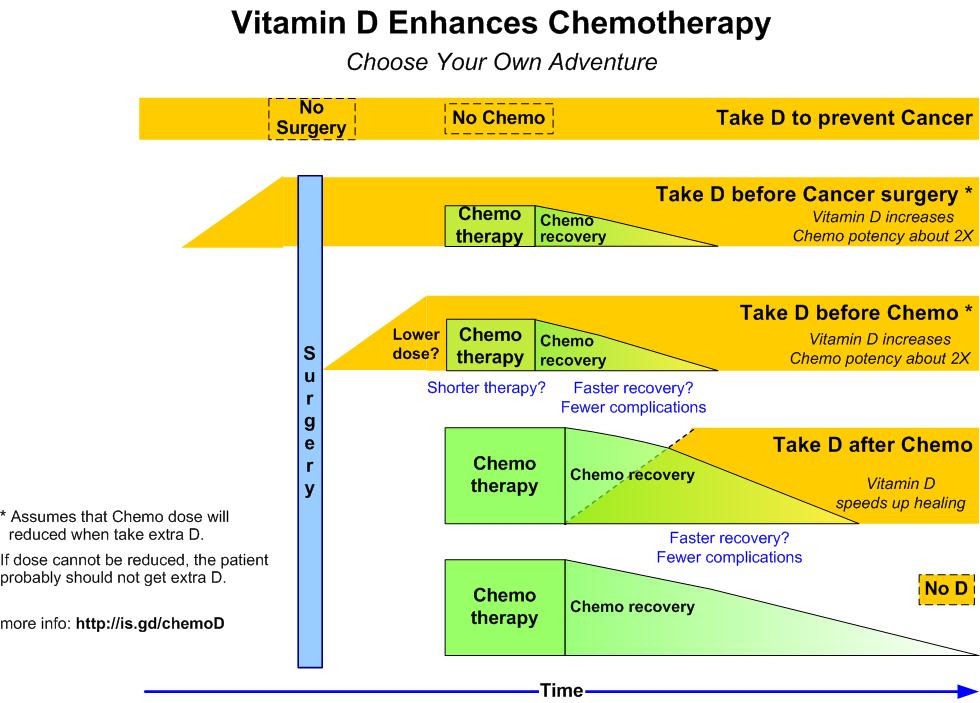Breast Cancer Chemo 35% more likely to be successful if more than 20 ng of Vitamin D – meta-analysis
Impact of Vitamin D Levels on Progression-Free Survival and Response to Neoadjuvant Chemotherapy in Breast Cancer Patients: A Systematic Review and Meta-Analysis
Cancers 2024, 16(24), 4206; https://doi.org/10.3390/cancers16244206
Alessandro Ottaiano 1ORCID,Bianca Arianna Facchini 2,Marialucia Iacovino 1,Mariachiara Santorsola 1,Sergio Facchini 2ORCID,Giordana Di Mauro 3,Enrica Toscano 3ORCID,Monica Montopoli 4ORCID,Annabella Di Mauro 5ORCID,Vincenzo Quagliariello 6,Nicola Maurea 6ORCID,Gianluca Vanni 7ORCID,Alessia Bignucolo 8ORCID,Liliana Montella 9ORCID,Marco Materazzo 7ORCID,Mario Roselli 10ORCID,Oreste Claudio Buonomo 7,† and Massimiliano Berretta 8,*,†ORCID
Simple Summary
Among the pleiotropic functions of vitamin D, its involvement as an anticancer synergistic compound has recently emerged. The active form of VD has been shown to induce cell cycle arrest, cell apoptosis, and autophagy, and to suppress angiogenesis and metastatic progression in the TME via various signal transduction pathways. Interest has focused on the ability of VD to enhance the antitumor activity of some cancer drugs, suggesting its potential role as a chemosensitizer in breast cancer therapy. From our meta-analysis, it emerged that adequate baseline VD levels are associated with a 22% reduction in the risk of a non-response to NACT and a 35% reduction in the risk of disease progression. These results suggest a new potential role of VD as prognostic biomarker of PFS and therapeutic response.
Abstract
Background: Breast cancer remains the leading cause of cancer-related deaths among women despite advances in early detection. Neoadjuvant chemotherapy (NACT) is now standard for early-stage BC, with vitamin D (VD) emerging as a potential prognostic biomarker considering its positive pleiotropic effects. This review and meta-analysis assess the impact of baseline VD levels on outcomes in BC patients undergoing NACT.
Methods: Inclusion criteria required patients to be over 18 years of age, have a pathologically confirmed BC diagnosis, and have their VD levels assessed prior to chemotherapy. Studies were included if they reported odds ratios (ORs) for response and/or hazard ratios (HRs) for PFS with 95% confidence intervals (CIs). A comprehensive literature search of PubMed/MEDLINE and Scopus/ELSEVIER (2014–2024) was conducted, and data were analyzed using fixed- and random-effects models, with Forest plots illustrating the results. Study quality and potential biases were assessed using the MINORS, NOS, and RoB2 scales, and statistical heterogeneity was evaluated with I2 statistics and funnel plots.
Results: Six studies were included in the analysis. All studies addressed stages II and III, with three also including stage I. The meta-analysis covered data from 722 patients regarding NACT response and 1033 patients for PFS. The results revealed a 22% reduction in the likelihood of non-response to NACT associated with adequate VD levels (low/deficient VD vs. high/sufficient VD; OR: 0.78; 95% CI: 0.30–1.25; p = 0.001) and a 35% reduction in progression risk with sufficient baseline VD levels (low/deficient VD vs. high/sufficient VD; HR: 0.65; 95% CI: 0.33–0.97; p < 0.001).
Conclusions: These findings highlight the significance of maintaining adequate vitamin D levels in BC treatment and encourage further studies to unravel the role of VD on cancer biology.
📄 Download the PDF from VitaminDWiki
VitaminDWiki – Overview Breast Cancer and Vitamin D contains:
{include}
VitaminDWiki – Cancer - After diagnosis category contains:
{include}
VitaminDWiki – WARNING Chemotherapy might be amplified by vitamin D

